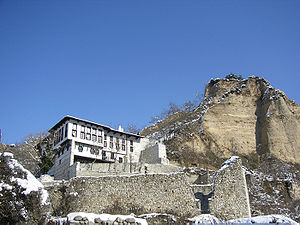
Kordopulov House
Encyclopedia


Bulgarian language
Bulgarian is an Indo-European language, a member of the Slavic linguistic group.Bulgarian, along with the closely related Macedonian language, demonstrates several linguistic characteristics that set it apart from all other Slavic languages such as the elimination of case declension, the...
: Кордопулова къща, Kordopulova kashta) is a large Bulgarian National Revival
Bulgarian National Revival
The Bulgarian National Revival , sometimes called the Bulgarian Renaissance, was a period of socio-economic development and national integration among Bulgarian people under Ottoman rule...
house in the southwestern Bulgaria
Bulgaria
Bulgaria , officially the Republic of Bulgaria , is a parliamentary democracy within a unitary constitutional republic in Southeast Europe. The country borders Romania to the north, Serbia and Macedonia to the west, Greece and Turkey to the south, as well as the Black Sea to the east...
n town of Melnik
Melnik, Bulgaria
Melnik is a town in Blagoevgrad Province, southwestern Bulgaria, in the southwestern Pirin Mountains, about 440 m above sea level. The town is an architectural reserve and 96 of its buildings are cultural monuments...
. It was built in 1754 specifically for wine production and was bought by the rich and known merchant Manol Kordopulov (or Manolis Kordopoulos). The house, possibly the largest of its kind and period, is located in the town's eastern part and consists of a ground floor that includes a wine cellar
Wine cellar
A wine cellar is a storage room for wine in bottles or barrels, or more rarely in carboys, amphorae or plastic containers. In an active wine cellar, important factors such as temperature and humidity are maintained by a climate control system. In contrast, passive wine cellars are not...
, a semi-basement for economic needs and a bay floor intended to be inhabited.
While the lower row of 12 windows is typically Bulgarian in style, the higher one is a mix of Venetian
Venice
Venice is a city in northern Italy which is renowned for the beauty of its setting, its architecture and its artworks. It is the capital of the Veneto region...
and Ottoman
Ottoman Empire
The Ottoman EmpireIt was usually referred to as the "Ottoman Empire", the "Turkish Empire", the "Ottoman Caliphate" or more commonly "Turkey" by its contemporaries...
architecture and is made of Venetian glass
Venetian glass
Venetian glass is a type of glass object made in Venice, Italy, primarily on the island of Murano. It is world-renowned for being colourful, elaborate, and skillfully made....
, making the house unique in Bulgaria.
The characteristic Melnik wine cellar is dug into the rock to form a tunnel. The cellar can take 300 ton
Ton
The ton is a unit of measure. It has a long history and has acquired a number of meanings and uses over the years. It is used principally as a unit of weight, and as a unit of volume. It can also be used as a measure of energy, for truck classification, or as a colloquial term.It is derived from...
s of wine, with the largest cask being able to take 12.5 tons alone. The corridors are relatively narrow and low at places and the cellar disposes of a ventilation system and special canals.
Two of the Kordopulov House's four floors are made of stone. Seven inner staircases connect the floors and garret
Garret
A garret is generally synonymous in modern usage with a habitable attic or small living space at the top of a house. It entered Middle English via Old French with a military connotation of a watchtower or something akin to a garrison, in other words a place for guards or soldiers to be quartered...
s and the two wooden floors are covered with motley rugs.
Bulgarian revolutionary Yane Sandanski
Yane Sandanski
Yane Ivanov Sandanski or Jane Ivanov Sandanski, was a revolutionary, one of the leaders of the Internal Macedonian-Adrianople Revolutionary Organization in the Serres region and head of the extreme leftist wing of the organization...
would use the house for shelter before World War I
World War I
World War I , which was predominantly called the World War or the Great War from its occurrence until 1939, and the First World War or World War I thereafter, was a major war centred in Europe that began on 28 July 1914 and lasted until 11 November 1918...
. The last of the Kordopulov family was killed in 1916 and the house passed to Agnesa, either a maid or a sister of a Kordopulov. She married Georgi Tsinstara and, although they had no children, they adopted their nephew Gavrail. He is in turn the father of Nikola Paspalev, the current owner. The Kordopulov House was renovated in 1974-1980 and is currently a private museum that is visited by 30,000 tourists a year.

